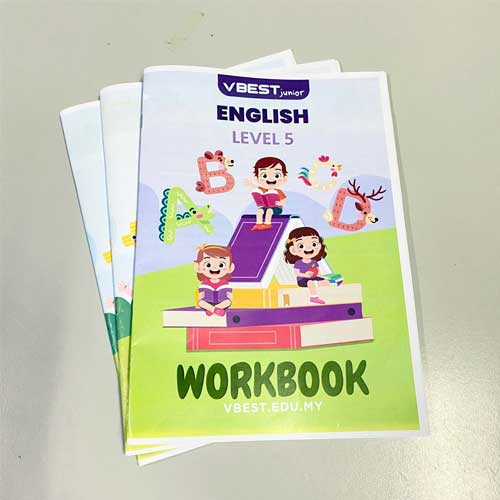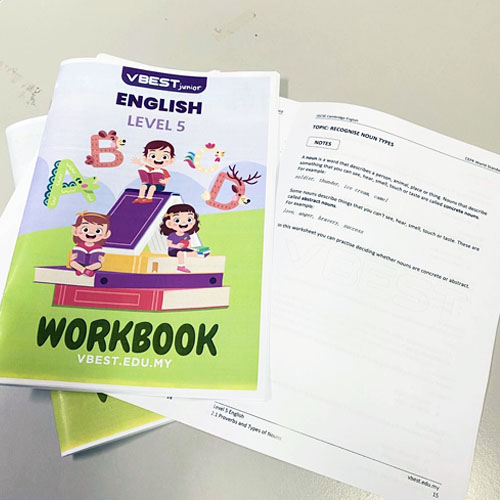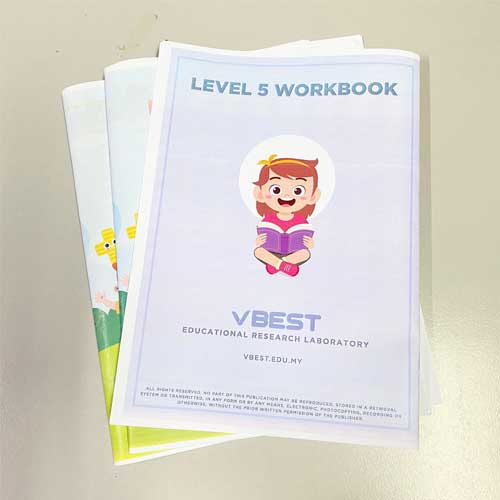
VBest Cambridge English Primary program offers classes for children between the ages of 3 to 13 years old.
Our program assists students in staying ahead of their peers in primary school.
English Workbook



Course Details
Suitable for 4 years old kids.
- Phonics Song ( Alphabet - Sound Associations )
- Singing ( Alphabet Song )
- Flash Card Learning ( Alphabet, Number, Body Parts, Animal, Transport, Food )
- Story Telling ( Level 1 )
- Pre Writing Skill ( Tracing Alphabet, Numbers, Body Parts, Animal, Transport, Food)
- Explore Learning ( Vocabulary Identification and Selection )
- Grammar Learning ( Nouns )
- Structured Play ( Board Games - Boggle )
- Role Play ( The Conflict Role Play )
- Gross and Fine Motor Skills
- Art and Craft Activity
Suitable for 5 years old kids.
- Phonics Song ( Initial Sound to Real Words )
- Phonics Song ( Number )
- Singing ( English Word, Number )
- Flash Card Learning ( English Word, Shapes, Colors, Transports, Clothing, Food, Toys )
- Story Telling ( Level 2 )
- Letter Formation and Writing Words
- Explore Learning ( Vocabulary Recognition and Selection )
- Grammar Learning ( Nouns, Adjectives and Verbs )
- Structured Play ( Board Games - Scrabble )
- Role Play ( The Cooperative Role Play )
- Listening Skills ( Listen to Keywords and Instructions to Complete a Task )
- Speaking Skills ( Using Appropriate Sentence Starters )
Suitable for 6 years old kids.
- Phonics Song ( Blending To Read, Learn Long Vowels and Recognize Spelling Pattern )
- Flash Card Learning ( Occupations, Sea Animals, Feelings & Weather, Sports, Vegetables, Fruits )
- Story Telling ( Level 3 )
- Construct Sentences Using Vocabulary Given
- Grammar Learning ( Nouns, Adjectives, Verbs and Prepositions )
- Structured Play ( Board Games - Upwords )
- Role Play ( Task-based role plays )
- Listening Skills ( Listening and Write it Down )
- Speaking Skills ( Describing and Giving Reasons for Answers )
- Writing Skills ( Writing Sentences and Punctuations )
- Using Adjective and a Variety of Vocabulary
- Composition
Chapter 1 Alphabet
1.1 Know Alphabet Order
1.2 Know Alphabet Order
Chapter 2 Phonemes
2.1 Phonological Awareness
2.2 Phonological Awareness
2.3 Phonological Awareness
2.4 Grapheme Awareness
2.5 Grapheme Awareness
2.6 Grapheme Awareness
2.7 Grapheme Awareness
2.8 Grapheme Awareness
2.9 Grapheme Awareness
2.10 Phonological Awareness
2.11 Phonological Awareness
2.12 Grapheme Awareness
2.13 Phonological Awareness
Chapter 3 Punctuations
3.1 Use Capital Letters
3.2 Read Words with Contractions
3.3 Punctuate Sentences
3.4 Punctuate Sentences
3.5 Overall
Chapter 4 Reading
4.1 Listen to and Discuss Texts
4.2 Read Aloud
4.3 Comprehension Exercise 1
4.4 Comprehension Exercise 2
Chapter 5 Sentence Structures
5.1 Check Own Work for Sense
5.2 Check Own Work for Sense
Chapter 6 Vocabulary
6.1 Phonological Awareness
Chapter 7 Work Structure
7.1 Use -ing, -ed, -er, and -est
7.2 Use -ing, -ed, -er, and est
7.3 Know Spelling Rules for Suffixes
7.4 Use-ing, -ed, er, and -est
7.5 Read Words with More Than One Syllable
7.6 Know Spelling Rules for Suffixes
Chapter 1 Spelling
1.1 Grapheme Awareness
1.2 Distinguish Different Spellings of Same Sound
1.3 Distinguish Different Spellings of Same Sound
1.4 Distinguish Different Spellings of Same Sound
1.5 Distinguish Different Spellings of Same Sound
1.6 Distinguish Different Spellings of Same Sound
1.7 Grapheme Awareness
1.8 Develop Grapheme Awareness
1.9 Develop Grapheme Awareness
1.10 Spell Common Exception Words
1.11 Grapheme Awareness
1.12 Distinguish Different Spellings of Same Sound
1.13 Grapheme Awareness
1.14 Spell in New Ways
1.15 Use Spelling Rules (1)
Chapter 2 Grammar
2.1 Use Past and Present Tense
2.2 Use Past and Present Tense
2.3 Use Past and Present Tense
Chapter 3 Phonemes
3.1 Phonological Awareness (1)
Chapter 4 Poetry
4.1 Recite by Heart
Chapter 5 Punctuation
5.1 Punctuation Awareness (1)
5.2 Use Sentences with Different Form
Chapter 6 Reading
6.1 Improve Understanding of Texts (1)
6.2 Phonological Awareness
6.3 Comprehension Exercise 1
6.4 Comprehension Exercise 2
6.5 Comprehension Exercise 3
6.6 Comprehension Exercise 4
Chapter 7 Revision
7.1 Year 2 Revision (1)
7.2 Year 2 Revision (11)
7.3 Year 2 Revision (111)
Chapter 8 Sentence Structure
8.1 Use Sentences with Different Forms
8.2 Use Sentences with Different Forms
Chapter 9 Word Meaning
9.1 Spell in New Ways
Chapter 10 Word Structure
10.1 Add Suffixes to Words (1)
10.2 Add Suffixes to Words (11)
10.3 Use Spelling Rules
10.4 Grammar Awareness
Chapter 11 Writing
11.1 Spell Common Exception Words (1)
11.2 Plan Ideas and Vocabulary
Chapter 1 Grammar
1.1 Common Nouns And Proper Nouns
1.2 Countable And Uncountable Nouns
1.3 Singular And Plural Nouns
1.4 Collective Nouns
1.5 Masculine And Feminine Nouns – Gender
1.6 Possessive Form Of Nouns1.7Noun Phrases
1.8 Personal Pronouns, Possessive Pronouns And Reflexive Pronouns
1.9 Demonstrative Pronouns
1.10 Interrogative Pronouns
1.11 Adjectives And Comparison Of Adjectives
1.12 Adjectival Phrases
1.13 Articles
1.14 Quantifiers
1.15 Present Simple Tense (1)
1.16 Present Simple Tense (2)
1.17 Present Continuous Tense (1)
1.18 Present Continuous Tense (2)
1.19 Past Simple Tense (1)
1.20 Past Simple Tense (2)
1.21 Past Continuous Tense (1)
1.22 Past Continuous Tense (2)
1.23 Present Perfect Tense (1)
1.24 Present Perfect Tense (2)
1.25 The Future– Will Or Shall And Going To Form (1)
1.26 The Future– Will Or Shall And Going To Form (2)
1.27 Modals (1)
1.28 Modals (2)
1.29 Modals (3)
1.30 Adverbs And Adverbials (1)
1.31 Adverbs And Adverbials (2)
1.32 Prepositions (1)
1.33 Prepositions (2)
1.34 Conjunctions (1)
1.35 Conjunctions (2)
1.36 Conjunctions (3)
Chapter 2 Vocabulary
2.1 Complete A Sentence
2.2 Choose The Best Verb
2.3 Recognise And Spell Irregular Plurals (1)
2.4 Recognise And Spell Irregular Plurals (2)
2.5 Use Accurate And Interesting Vocabulary
2.6 Use Vocabulary In Dialogue
2.7 Synonyms
Chapter 3 Poetry
3.1 Poetry ‘Moon’
3.2 Poetry ‘Kite’
Chapter 4 Punctuation
4.1 Punctuate Direct Speech
4.2 Use Speech Marks Accurately
Chapter 5 Reading
5.1 Distinguish Between Formal And Informal Letter
5.2 Distinguish Between Fiction And Non-Fiction
5.3 Interesting Phrases – The Wind In The Willows (1)
5.4 Interesting Phrases – The Wind In The Willows (2)
5.5 Organise Information Into Paragraphs
5.6 Read And Understand Fables ‘The Ant And The Grasshopper’
5.7 Read And Understand Fables ‘The Fox And The Stork’
5.8 Read And Understand Fables ‘The Lion And The Mouse’
5.9 Read And Understand Fables ‘The Tortoise And The Hare’
5.10 Read And Understand Instructions – Recipes
5.11 Read And Understand Instructions – Game
5.12 Read And Understand Non-Chronological Report
5.13 Read And Understand Stories From Other Cultures ‘Baboushka’
5.14 Read And Understand Stories From Other Cultures ‘Baucis And Philemon’
5.15 Read And Understand Stories From Other Cultures ‘The Merchant’s Purse’
5.16 Read And Understand Traditional Stories ‘Dick Whittington’
5.17 Read And Understand ‘The Emperor’s New Clothes’
5.18 Select Key Words In Order To Make Notes
5.19 Understand The Conventions Of Playscripts
5.20 Understand The Conventions Of Written Instructions
Chapter 6 Sentence Structure
6.1 Time Connectives
6.2 Join Sentences In Different Ways
6.3 Sentence Composition – Main And Subordinate Clauses
6.4 Sentence Meaning – Investigate Essential Words
Chapter 7 Spelling
7.1 Spell Commonly Used Tricky Words
7.2 When ‘ch’ Sound Like ‘k’
Chapter 8 Word Meaning
8.1 Understand Dictionary Definitions
Chapter 9 Writing
9.1 Organise Facts Into Coherent Paragraphs
9.2 Write A Thank You Letter
9.3 Write Descriptions Of Places
9.4 Write Instructions For A Game Or Recipe
Chapter 1 Grammar
1.1 Classify Adjectives by Type, Identify Adjectives in Sentences
1.2 Identify Adverbs In a Sentence
1.3 Investigate Prepositions
1.4 Know Your Tenses: How They Relate To The Purpose and Structure of Texts, Understand Tenses
1.5 Understand Definite and Indefinite Articles
Chapter 2 Vocabulary
2.1 Descriptive Writing: Using Powerful Verb, Identify Powerful Verbs In
Sentences
2.2 Using Dictionaries, Use Knowledge of Etymology
2.3 Using Adjectives
Chapter 3 Poetry
3.1 Using Rhythm To Perform Poetry, Identity Different Patterns Of Rhyme
in Poetry
3.2 Identify Text Meaning, Compare Poems on a Similar Theme
3.3 Discuss Text: 'Macavity-The Mystery Cat'
3.4 Read and Understand Poetry 'From A Railway Carriage' and Twins'
Chapter 4 Punctuation
4.1 Know Your Apostrophes: Making Possession
Chapter 5 Reading
5.1 Analyse The Techniques Used To Write Newspaper Headlines, Identify The Features
5.2 Distinguish Between Facts and Opinions
5.3 Distinguish Between Explanations, Instructions and Non-Chronological
5.4 Report, Examine How Author Develop Characters In Their Stories
5.5 Identify The Key Features Of an Explanatory Text
5.6 Reading Story: 'Mary The Girl Guide', 'Ants', 'Rosie The Blind Telephone Operator'
5.6 Reading Story: 'The Three Fools', The Art Of Boxing', 'Edible Bird's Nests'
5.7 Reading Myths 'Baucis and Philemon'
5.8 Reading Legends 'Paul Bunyan'
5.9 Reading Myths: 'Finn McCool'
5.10 Retrieve and Record Information: 'The Ancient Egyptians'
5.11 Understand Personification, Understand The Importance Of Settings: 'The Secret Garden'
Chapter 6 Sentence Structure
6.1 Using 'If
6.2 Sentence Composition: Phrases and Clauses', Sentence Composition: Single and Multi Clauses
6.3 Understand The Significance Of Word Order
Chapter 7 Spelling
7.1 Spell Two-Syllable Words Containing Adjacent Consonants, Investigate Word Pronunciations
7.2 Words Beginning With C and 'K', Words With 'CK'
7.3 [Spelling 'ch' or 'sh', Spelling 'u' or ou', Spelling "I' or 'y'
Chapter 8 Word Meaning
8.1 Complete a Sentence
8.2 Know Your Homophones: to, too and two
8.3 Know Your Terminology
Chapter 9 Word Structure
9.1 Change The Gender Of Words
9.2 Know Your Prefixes: 'sub, 'ad-' and 'al-*
9.3 Know Your Suffixes: *ive' and 'cian'
9.4 Know Your Suffixes: Make Adjectives Into Nouns
9.5 Know Your Prefixes and Suffixes: Forming Diminutives, Adding Prefixes
9.6 Root Words: Using Suffixes To Make Verbs
Chapter 10 Writing
10.1 Practice Your Pronouns: First, Second and Third Person, Summarise The Content of a Passage
10.2 Read and Understand: *The Ugly Duckling'
10.3 Write a Passage of Dialogue
10.4 Write a First Person Account
10.5 Write Contrasting Descriptions of The Same Setting
Chapter 1 Grammar
1.1 Active, Interrogative and Imperative Sentences 1, Active, Interrogative and Imperative Sentences 2
1.2 Imperative Form
1.3 Understand Auxiliary Verbs
1.4 Understand Modal Verbs 1, Understand Modal Verbs 2
1.5 Use Modal Verbs and Adverbs To Show Degree of Possibility
Chapter 2 Vocabulary
2.1 Standard and Non-Standard English – How to Differentiate 1, Standard and Non-Standard English – How to Differentiate 2, Standard and Non-Standard English – How to Differentiate 3
2.2 Making Vocabulary Choice 1, Making Vocabulary Choice 2, Making Vocabulary Choice 3
Chapter 3 Poetry
3.1 Identify Elements of Poetry, Haiku Poems – Understanding The Features, Learn Facts From a Poem
3.2 Read and Interpret Narrative Poetry – ‘The Listeners’, Read and Understand Poetry – ‘I Saw Three Witches’
3.3 Analyse Poetry
3.4 Label The Rhyme Scheme
Chapter 4 Punctuation
4.1 Grammatical Boundaries – Using Commas In Sentences
4.2 Using Commas and Subordinate Clauses 1, Using Commas and Subordinate Clauses 2
4.3 Use Bracket and Dashes For Parenthesis, Punctuating Dialogue
Chapter 5 Reading
5.1 Compare Objective and Subjective Texts, Read and Interpret Instructions, Identify The Purpose of a Text
5.2 Read and Understand ‘What Katy Did’ 1, Read and Understand ‘What Katy Did’ 2, Read and Understand ‘What Katy Did’ 3
Chapter 6 Sentence Structure
6.1 Direct and Reported Speech – Know The Difference 1,
Direct and Reported Speech – Know The Difference 2,
Direct and Reported Speech – Know The Difference 3
6.2 Recognise Noun Phrases
6.3 Changing Word Order
6.4 Understand Relative Clauses 1,
Understand Relative Clauses 2,
Understand Relative Clauses 3
6.5 Understand Terminology - Connectives
Chapter 7 Spelling
7.1 Dictionary Skills – Finding the Skills You Need
7.2 Investigate Words With Silent Letters ‘k’ and ‘g’
7.3 Investigate Words With Silent Letters ‘w’ and ‘h’
7.4 Investigate Words With Silent Letters ‘b’ and ‘l’
Chapter 8 Word Meaning
8.1 Distinguish Between Common Homophones 1,
Distinguish Between Common Homophones 2
8.2 Recognise Similes and Metaphors 1,
Recognise Similes and Metaphors 2
8.3 Understand How Acronyms Are Formed
Chapter 9 Word Structure
9.1 Know Your Pronunciations – ‘ough’,
Know Your Pronunciations – ‘ough’ and ‘ou’
9.2 Know Your Suffixes – ‘-ible’ and ‘-able’
9.3 Know Your Suffixes – ‘-ology’
9.4 Revise Verb Endings ‘-s’, ‘-ed’ and ‘-ing’ 1,
Revise Verb Endings ‘-s’, ‘-ed’ and ‘-ing’ 2
9.5 Revise Your Suffixes – ‘-cian’, ‘-sion’ and ‘-tion’,
Revise Your Suffixes – ‘-sion’
9.6 Understand Verb Prefixes – ‘De-’ 1,
Understand Verb Prefixes – ‘De-’ 2
9.7 Understand Verb Prefixes – ‘Dis-’ 1,
Understand Verb Prefixes – ‘Dis-’ 2
9.8 Understand Verb Prefixes – ‘Mis-’ 1,
Understand Verb Prefixes – ‘Mis-’ 2
9.9 Understand Verb Prefixes – ‘Over-’ 1,
Understand Verb Prefixes – ‘Over-’ 2
9.10 Understand Verb Prefixes – ‘Re-’ 1,
Understand Verb Prefixes – ‘Re-’ 2
9.11 Use Hyphens to Join Prefixes to Root Words 1,
Use Hyphens to Join Prefixes to Root Words 2,
Use Hyphens to Join Prefixes to Root Words 3
Chapter 10 Writing
10.1 Composition – How to Write For Your Audience 1,
Composition – How to Write For Your Audience 2,
Composition – How to Write For Your Audience 3
10.2 Topic Research – Asking The Right Questions,
Identify an Author’s Statement of Opinion
10.3 Write a Detailed Character Description
10.4 Find The Main Idea of Passage
10.5 Match Solution with The Solution
Chapter 1 Grammar
1.1 Adverbs, Present past participle, Prepositions and adverb particles
1.2 Adjectives and adjectival phrases
1.3 Tenses and verbs (1,2)
1.4 Pronouns, Subject-verb agreement
1.5 Passive and active voice, Impersonal speech
1.6 Direct and indirect speech, Modal auxiliaries
1.7 Connectors and connectives
1.8 Connectives (1,2,3,4)
1.9 Using colons correctly
1.10 Using semi-colons correctly (1,2,3)
1.11 Subject and object, Changes of meaning through time
1.12 Edit texts, Dashes
1.13 Official and formal language
1.14 Manipulating sentence structure for effect (1,2,3)
1.15 Role playing (1,2,3,4)
Chapter 2 Vocabulary
2.1 Proverbs, Type of nouns
2.2 Identify antonyms and synonyms (1)
2.3 Know your prefixes (1,2)
2.4 Know your prefixes (3,4,5)
2.5 Identify antonyms and synonyms (2)
2.6 Know your roots (1,2,3)
2.7 Know your roots (4,5)
2.8 Know your suffixes (1,2)
Chapter 3 Comprehension
3.1 Comprehension (1,2,3)
3.2 Comprehension (4,5,6)
3.3 Comprehension (7,8,9)
3.4 Comprehension (10,11,12)
Chapter 4 Writing
4.1 Writing a non-chronological report
4.2 Writing a persuasive text
4.3 Writing a discussion text
4.4 Writing an explanatory text
4.5 Writing an instruction text
4.6 Writing a recount
Chapter 5 Poetry
5.1 Understand poetry terms, Compare two poems (1,2)
Chapter 6 Sat Practice
6.1 SAT Practice 1
6.2 SAT Practice 2
6.3 SAT Practice 3
6.4 SAT Practice 4
6.5 SAT Practice 5
6.6 SAT Practice 6
6.7 SAT Practice 7
6.8 SAT Practice 8
6.9 SAT Practice 9
6.10 SAT Practice 10
Things To Know | Frequently Asked Questions FAQs
How Long is the Duration for Each Lesson?
Each lesson will take from 60 minutes to 120 minutes depending on the subject and level.
How I know which class is suitable for my child?
We will provide assessment exam to test on their level before deciding which class they should attend.
Is this a private lesson?
Yes. It will be a 1 to 1 lesson. We can focus more on teaching each child.
What age group of children is suitable to attend VBest primary lesson?
We offers classes for children between the ages of 3 to 13 years old.
Will there be notes provided?
Yes, we will provide workbooks and notes for our students.
Book Class Now
We want your child to walk into a class that fits him and go to a teacher he likes to start his journey of academic excellence.
Our People
Downloads